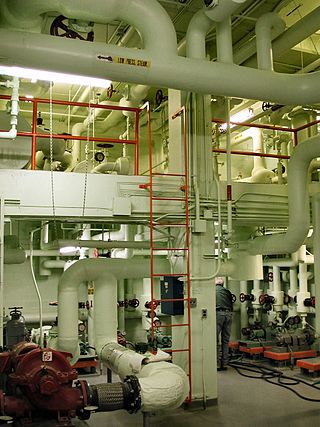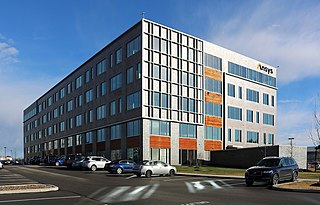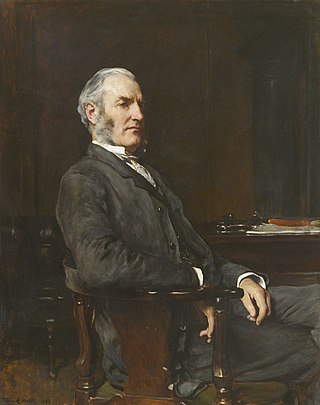
Mechanical engineering is the study of physical machines that may involve force and movement. It is an engineering branch that combines engineering physics and mathematics principles with materials science, to design, analyze, manufacture, and maintain mechanical systems. It is one of the oldest and broadest of the engineering branches.

Harland & Wolff is a British shipbuilding and fabrication company headquartered in London with sites in Belfast, Arnish, Appledore and Methil. It specialises in ship repair, shipbuilding and offshore construction. Harland & Wolff is famous for having built the majority of the ocean liners for the White Star Line, including Olympic-class trio – RMS Olympic, RMS Titanic and HMHS Britannic. Outside of White Star Line, other ships that have been built include the Royal Navy's HMS Belfast; Royal Mail Line's Andes; Shaw, Savill & Albion's Southern Cross; Union-Castle's RMS Pendennis Castle; P&O's Canberra; and Hamburg-America's SS Amerika of 1905. Harland and Wolff's official history, Shipbuilders to the World, was published in 1986.

Within industry, piping is a system of pipes used to convey fluids from one location to another. The engineering discipline of piping design studies the efficient transport of fluid.
British Shipbuilders (BS) was a public corporation that owned and managed the shipbuilding industry in Great Britain from 1977 through the 1980s. Its head office was at Benton House in Newcastle upon Tyne, England.
Reliability engineering is a sub-discipline of systems engineering that emphasizes the ability of equipment to function without failure. Reliability describes the ability of a system or component to function under stated conditions for a specified period of time. Reliability is closely related to availability, which is typically described as the ability of a component or system to function at a specified moment or interval of time.

Ansys, Inc. is an American multinational company with its headquarters based in Canonsburg, Pennsylvania. It develops and markets CAE/multiphysics engineering simulation software for product design, testing and operation and offers its products and services to customers worldwide.

The Loch class was a class of anti-submarine (A/S) frigate built for the Royal Navy and her Allies during World War II. They were an innovative design based on the experience of three years of fighting in the Battle of the Atlantic and attendant technological advances. Some shipyards had trouble building these larger ships, which led to widespread use of the Castle-class corvette, introduced around the same time.

Samson and Goliath are the twin shipbuilding gantry cranes situated at Queen's Island, Belfast, Northern Ireland. The cranes, which were named after the Biblical figures Samson and Goliath, dominate the Belfast skyline and are landmark structures of the city. Comparative newcomers to the city, the cranes rapidly came to symbolise Belfast in a way that no building or monument had hitherto done.

The American Bureau of Shipping (ABS) is an American maritime classification society established in 1862. Its stated mission to promote the security of life, property, and the natural environment, primarily through the development and verification of standards for the design, construction and operational maintenance of marine and offshore assets.

Sir Edward James Harland, 1st Baronet, was an Ulster-based English shipbuilder and politician. Born in Scarborough in the North Riding of Yorkshire, he was educated at Edinburgh Academy. In 1846, aged 15, he took an apprenticeship at the engineering works of Robert Stephenson and Company in Newcastle upon Tyne. Afterwards he was employed in jobs in Glasgow and again in Newcastle, before moving to Belfast in 1854 to manage Robert Hickson's shipyard at Queen's Island. Four years later he bought the yard and renamed the business Edward James Harland and Company. In 1861 he formed a business partnership with Gustav Wilhelm Wolff, his former personal assistant, creating Harland and Wolff. Later, Harland recruited William James Pirrie as another partner. Edward Harland, Gustav Wolff and William James Pirrie maintained a successful business, receiving regular orders from the White Star Line, before Harland's retirement in 1889, leaving Wolff and Pirrie to manage the shipyard.

Sir Thomas John Parker is a British businessman. He is chairman of Laing O'Rourke and former chairman of Pennon Group, a director of Carnival Corporation & plc and lead non-executive director at the Cabinet Office. He has been a director or chairman of numerous other public companies including Airbus, Anglo American plc, Babcock International, British Gas, DP World, Lattice Group, National Grid plc and Ombu Group. He is a past President of the Royal Academy of Engineering, patron at the Centre for Process Innovation and a Visiting Fellow of the University of Oxford.

CargoMax is a stability and load management software application for marine and offshore industries. It is developed and sold by Herbert-ABS Software Solutions, LLC. First released in 1979, CargoMax was one of the first computerized systems for planning and evaluating ship loading; it is currently one of the most-used software applications for this purpose. It helps determine cargo loading sequences by calculating stability and stress based on ship models created from vessel data: lightship weights, hydrostatic characteristics, tank data, and allowable shear forces and bending moments. Naval architects and engineers from Herbert-ABS customize each CargoMax installation using shipyard drawings and technical data. Different installations also include different sets of features from the program.

A20 was a British tank design by Harland and Wolff to meet an Army requirement for an infantry tank that could replace the Matilda II and Valentine tank. It was designed in the expectation that conditions would be similar to those of the First World War.

The dynamic design analysis method (DDAM) is a US Navy-developed analytical procedure for evaluating the design of equipment subject to dynamic loading caused by underwater explosions (UNDEX). The analysis uses a form of shock spectrum analysis that estimates the dynamic response of a component to shock loading caused by the sudden movement of a naval vessel. The analytical process simulates the interaction between the shock-loaded component and its fixed structure, and it is a standard naval engineering procedure for shipboard structural dynamics.

Alexander Montgomery Carlisle, PC brother-in-law to Viscount Pirrie, was one of the men involved with designing the Olympic-class ocean liners in the shipbuilding company Harland and Wolff. His main area of responsibility was the ships' safety systems such as the watertight compartments and lifeboats. As a Privy Councillor, he was known as "The Right Honorable".

SDC Verifier is a commercial finite element analysis post-processor software with a calculation core for checking structures according to different standards, either predefined or self programmed, and final report generation with all checks. The goal is to automate routine work and speed up a verification of the engineering projects. It works as an addon for popular FEA software Ansys, Femap and Simcenter 3D.

The Jubilee class were a group of five passenger and cargo ocean liners built by Harland and Wolff at Belfast, for the White Star Line, specifically for the White Star Line's service from the UK to Australia on the Liverpool–Cape Town–Sydney route. The five ships in order of the dates they entered service were:

HMS Alisma was a Flower-class corvette that served in the Royal Navy.

The Arrol Gantry was a large steel structure built by Sir William Arrol & Co. at the Harland and Wolff shipyard in Belfast, Northern Ireland. It was built to act as overhead cranes for the building of the three Olympic-class liners.
The Fleet Solid Support Ship Programme (FSSP) aims to deliver up to three fleet solid support ships to the British Royal Fleet Auxiliary. The ships will be used to provide underway replenishment of dry stores, such as ammunition, spare parts and supplies, to ships of the Royal Navy. They will regularly deploy with the UK Carrier Strike Group, providing crucial supplies to the Queen Elizabeth-class aircraft carriers and their escorts. All three ships had been scheduled to enter service between 2028 and 2032. However, subsequently the Ministry of Defence indicated that the first ship would in fact not be operational until 2031.
















